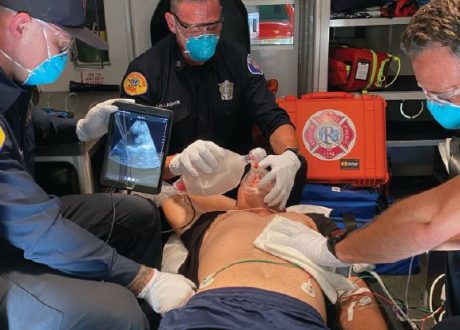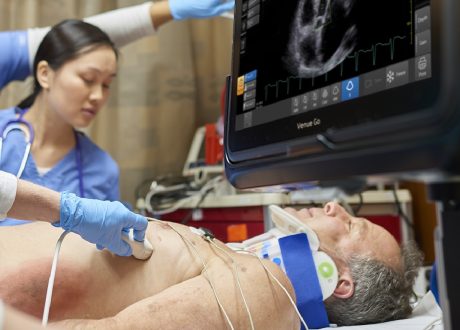Podcast: Play in new window | Download
“This learning material is sourced from Emergency Medicine Cases and has been published here with permission as per creative commons copyright”

Topics in this EM Quick Hits podcast
Megan Landes on the importance of diagnosing HIV in the ED (1:10)
Jesse McLaren on the failed paradigm of STEMI criteria and ECG tips to identify acute coronary occlusion (22:33)
Anand Swaminathan on evidence for non-invasive airway management in the poisoned patient (29:25)
Brit Long and Hans Rosenberg on the identification, workup and management of spontaneous bacterial peritonitis (37:32)
Matt Poyner on the most lucrative side-gig, DIY investing (46:34)
Podcast production, editing and sound design by Anton Helman
Written summary & blog post by Shaila Gunn & Megan Landes, edited by Anton Helman
Cite this podcast as: Helman, A. Landes, M. McLaren, J. Swaminathan, A. Long, Rosenberg, H. B. Pointer, M. EM Quick Hits 57 – HIV diagnosis, Failed Paradigm of STEMI Criteria, Poisoned Patient Airway Management, Spontaneous Bacterial Peritonitis, DIY Investments. Emergency Medicine Cases. June, 2024. https://emergencymedicinecases.com/em-quick-hits-june-2024/. Accessed June 23, 2024.
HIV diagnosis and why it’s important in EM

HIV is a commonly missed diagnosis. 1 in 7 HIV+ Canadians are unaware of their diagnosis.
For many people at high risk for HIV, the ED is the only accessible place to get tested. An early diagnosis saves lives by initiating early treatment, thus preventing transmission of the infection by 96% (undetectable = untransmissible).
In whom should we consider testing for HIV in the ED?
1a) Major risk factor for HIV – persons who inject drugs (PWID), indigenous people, and people from endemic areas, suspect TB plus
1b) Clinical condition associated with HIV
-
- Acute retroviral syndrome: an influenza like illness that happens within the first month of seroconversion. Influenza like illness + risk factor = think HIV.
- Opportunistic infections: may include angular cheilitis, aphthous ulcers, oral candida, and hairy leukoplakia (from left to right in image below). The clues are in the mouth, so examine it! Be suspicious of unexpected weight loss and chronic diarrhea.

Opportunistic infections of the mouth in people with HIV, from left to right, angular cheilitis, aphthous ulcers, oral candida, and hairy leukoplakia
-
- AIDS defining illnesses: severe wasting, esophageal candida, and PCP/PJP pneumonia (may be identified by characteristic ‘bag wing’ bilateral pneumonia) are the most common. Also consider unusual CNS presentations including altered mental status, meningitis, and encephalitis.
2.Anyone who requests a test
3. Unexplained pancytopenia
- Other risk factors for HIV: People presenting with any STI, people with multiple sexual partners and people with recurrent presentations for post-exposure prophylaxis (PEP).
=> Integrating IVDU and sexual history into your history for all adult patients presenting with a fever will improve your diagnostic pick up rate of HIV
Testing should be done through whatever means you have access to at your institution. This may include point of care testing, self-testing with oral swabs, or lab-based antigen-antibody tests. Note, if the test if negative and you have high suspicion, repeat testing in 1-3 months as false negatives are common early in the natural history of HIV.
Other illnesses to be aware of in HIV+ patients
- Immune reconstitution inflammatory syndrome: This is a paradoxical worsening of any pre-existing infectious processes 30-60 days after starting antiretrovirals. Essentially, it is an unmasking of an infectious process.
- Pulmonary embolism: HIV increases the risk 2-10x by inducing a prothrombotic state (increased anticardiolipin antibodies + protein C and S deficiency).
- Acute coronary syndrome: HIV increases the risk of ACS by 1.5-2x, likely due to an inflammatory state. Antiretroviral therapy also can increase serum lipids.
Bottom line => Test for HIV in the ED in patients with one or more risk factors + any clinical suspicion of an HIV related disease, as starting anti-retroviral therapy early in the disease process prolongs life and prevents the spread of HIV; testing not only improves mortality rates for the patient being tested but is public health service to your community.
Failed paradigm of STEMI criteria – ECG abnormalities to identify acute coronary occlusion and avoid pitfalls
Adherence to STEMI criteria without considering other ECG patterns of acute coronary occlusion is one of the most common causes of delay to coronary reperfusion. Using STEMI criteria, if the criteria are not met, it is by definition a NSTEMI/non-occlusive MI that requires non-urgent angiography. STEMI criteria are only 44% sensitive for acute coronary occlusion.
Pitfalls of STEMI criteria
- ECG abnormalities may be subtle or open to different interpretation i.e. early repolarization or pericarditis.
- Only borderline or minimal ST-elevation may be present and the ED physician may be unsure of its significance.
- LVH/LBBB may complicate the ECG diagnosis.
- Physician may suspect the ST elevation is old but not have ECG’s available for comparison.
Below are some pitfalls of ECG interpretation and evidence-based ECG abnormalities to help identify acute coronary occlusion.
Pitfall: Subtle anterior ST elevation interpreted as early repolarization without considering LAD occlusion.
Ischemic abnormalities beyond the ST segment that exclude a normal variant:
- Anterior Q waves
- Convex ST elevation
- Terminal QRS distortion (lack of S/J wave on V2/3)
- Precordial ST depression or T-wave inversion
- Inferior reciprocal change
- Hyperacute T waves or disproportionate ST elevation compared to the previous QRS
Pitfall: subtle inferior ST elevation interpreted as early repolarization, pericarditis without considering inferior occlusion MI.
Ischemic abnormalities beyond the ST segment that exclude a normal variant:
- Inferior hyper acute T waves
- Reciprocal ST depression in aVL
- Anterior ST depression from posterior MI
Pitfall: assuming that occlusion MI cannot be diagnosed in the presence of LBBB.
Smith-Modified Sgarbossa criteria can be used to identify superimposed primary ischemic change:
- Any lead with concordant ST elevation
- Concordant ST depression anteriorly
- Discordant ST elevation > 25% or the preceding S wave
Pitfall: assuming that anterior Q-waves with subtle ST elevation are caused by an old LV aneurysm without considering new anterior STEMI.
- If subtle ST elevation is follow by a hyperacute T-wave >1/3 of the size of the preceding QRS complex, this indicates an acute anterior STEMI.
Pitfall: assuming that all occlusion MIs must have ST elevation and that precordial ST depression are caused by non-specific subendocardial ischemia without considering a posterior occlusion MI.
- If ST depression if maximal in V1-4, this is specific for posterior occlusion MI
- Look for primary T-wave changes including hyperacute T-waves in acute occlusion and Wellens waves in spontaneous reperfusion at risk for re-occlusion.
Together, these criteria increase the sensitivity for occlusion MI to 80% with preserved specificity. In addition, we must use other clinical bedside tools to aid in the diagnosis of occlusion MI including: clinical features of refracting ischemia, hemodynamic or electrolyte instability, or POCUS findings like new regional wall motion abnormalities.
ECG Cases 50 – STEMI is a Failed Paradigm, Enter OMI
ECG Cases 49 – ECG and POCUS for Dyspnea and Chest Pain
ECG Cases 41 – STEMI, Occlusion MI Complications
Bottom line => In patients presenting with chest pain or an anginal equivalent and subtle ECG changes, it should not be a question of whether the patient meets STEMI criteria only, but also include clinical factors (refractory ischemia, hemodynamic/electrolyte instability) in combination with the above occlusion MI criteria as well as PoCUS findings to help rapidly identify occlusion MI requiring emergency cath lab activation or thrombolysis.
When to intubate the poisoned patient? An RCT of non-invasive airway management in comatose poisoned patients
The old adage “GCS <8, must intubate” is laden with problems. The decision to intubate is a complex one that does not have a simple solution. GCS was created for brain injured patients and has poor inter-rater reliability. We should not rely on a single, unreliable parameter, to decide when to intubate.
Effect on non-invasive airway management in comatose patients with acute poisoning, a randomized control trial by Freund et al. JAMA 2023.
- P: Patients with a GCS <9 with presumed intoxication as the cause of the change in GCS.
- I: Conservative strategy where intubation was delayed until a emergency criteria for intubation was met including seizure, respiratory distress, vomiting, and shock.
- C: Standard routine practice (i.e. at the discretion of the emergency physician).
- O: Rate of intubation: 18% in the conservative group, 60% in the standard practice group, NNT 2.5 (i.e. for every 3 patients seen, one does not get intubated). Rates of pneumonia: 7% in the conservative group, 14% in the standard routine practice group. The standard routine practice group also had a higher rate of all adverse outcomes.
There is no role for assessing for gag reflex in the comatose patient. Intubating a patient because a patient does not have a gag reflex is a bad practice, as many people have a poor gag reflex at baseline and because testing for the gag reflex increases the risk of vomiting and aspiration.
Bottom line => Deciding which poisoned patients require a definitive airway is a nuanced decision. Intubation is associated with significant increased harm. Do a full assessment integrating multiple clinical factors to guide management. For most patients, this means waiting to intubate. If there is NOT an immediate risk for decompensation, hypercarbia, hypoxemia, or hypoventilation, consider non-invasive ventilation and serially reassessments.
Evaluation and management of spontaneous bacterial peritonitis
Spontaneous bacterial peritonitis (SBP) is a bacterial infection of ascitic fluid without any apparent intra-abdominal focus in patients with cirrhosis. It is the most common infection in people with cirrhosis, compromising 30% of all infections and present in 5-30% of cirrhotic patients admitted with ascites. It has significant mortality with 15-40% overall mortality and a 1 year survival rate of only 40%.
The classic triad of symptoms is abdominal pain, fever, and altered mental status. However, 1/3 cases are asymptomatic or have mild symptoms. Our sensitivity based on clinical exam is only 40-75%.
- Abdominal pain is 90% sensitive but not specific
- Fever is not sensitive, especially as mild hypothermia is normal in patients with cirrhosis. Marked hypothermia is specific for SBP and is a poor prognostic factor
- Altered mental status is present in 50% of patients; it may be subtle, so make sure you ask a family member
Pitfall: do not rule out SBP based on a “benign” abdominal physical exam; ascites can prevent the development of classic peritoneal signs by creating a separation between the visceral and parietal peritoneum
The diagnostic test of choice for spontaneous bacterial peritonitis is paracentesis
Tips for paracentesis and treating with IV albumin after paracentesis in patients suspected of SBP
- Perform the paracentesis early; every hour delay in obtaining fluid is associated with a 3.3% increase in mortality.
- Send the ascitic fluid for cell count and differential, culture and sensitivity, and protein; an ANC >250 is diagnostic.
- If you send 10mL of ascitic fluid in a blood culture bottle, this increases the sensitivity of the culture to >90%.
- Paracentesis is relatively safe; there is a <2% complications requiring intervention; guidelines do not recommend routinely checking INR/platelets prior to paracentesis; patients generally do not require a blood product transfusion before paracentesis.
- Perform a PoCUS to help find the deepest pocket, identify vessels, and measure wall thickness.
- Post paracentesis for patients suspected of SBP, albumin should be administered to decrease renal impairment and mortality with an NNT 5, 6 respectively. Albumin dosing after paracentesis is 1.5g/kg IV within 6 hours.
- For patients without SBP, albumin is warranted post-paracentesis if >5 L removed to reduce risk of post-paracentesis circulatory dysfunction, although the evidence for this is not strong; avoid removing >6-8L for this reason.
Antibiotic treatment of SBP
- First line antibiotic of choice is usually a 3rd generation cephalosporin like ceftriaxone or cefotaxime
- In critically ill patients, those with end organ injury, recent hospitalization with antibiotics, or recurrent SBP piperacillin-tazobactam or carbapenem is indicate
- If there is a history of MRSA, add vancomycin or linezolid
Bottom line => Consider SBP in any patient with ascites plus fever, abdominal pain, or altered mental status. Paracentesis is a safe procedure and should be performed in patients with cirrhosis and ascites who have suspected SBP, upper GI bleeds, or complications of their cirrhosis. Platelets/INR do not necessarily need to be checked prior to paracentesis. If you suspect SBP, treat the patient with appropriate antibiotics early, usually a 3rd generation cephalosporin.
Deep dive into spontaneous bacterial peritonitis and paracentesis on Episode 149 Liver Emergencies: Thrombosis and Bleeding, Portal Vein Thrombosis, SBP, Paracentesis Tips and Tricks










